Synthetic Data, Real Impact: How to Fake It 'Til You Make It in Marketing
In the era of data-driven decision-making, having access to quality data can be the difference between a successful marketing campaign and one that misses the mark (or worse, becomes the subject of a Twitter roast). But acquiring high-quality marketing data isn't always easy. Privacy regulations, budget constraints, and limited access to diverse datasets can pose significant challenges. That’s where synthetic data swoops in like a data superhero.
Synthetic data is artificially generated data that mimics the structure and patterns of real-world data. It’s created using advanced algorithms and can be tailored to meet specific needs—making it an invaluable tool for marketers. In this blog post, we’ll explore how you can use AI to create synthetic marketing data and leverage it for your campaigns. Spoiler alert: It’s easier than explaining your ad spend to the finance team.
Why Synthetic Data for Marketing?
Before diving into the how, let’s understand the why. Synthetic data offers several advantages for marketers:
Privacy Compliance: It eliminates the risk of violating privacy laws like GDPR and CCPA since no real personal data is involved. No more sleepless nights worrying about regulators knocking on your door.
Cost-Effective: It reduces the need for expensive data collection processes, leaving you with more budget for coffee or, you know, actual campaigns.
Scalability: You can generate as much data as needed to train marketing models or test campaigns. Think "unlimited buffet" but for data.
Diversity: Synthetic data allows you to simulate different customer personas, behaviors, and scenarios. Want to market to unicorn enthusiasts in Antarctica? Done.
Steps to Create Synthetic Marketing Data
Define Your Objectives
Determine the type of marketing data you need, such as customer demographics, purchase behaviors, or campaign performance metrics.
Establish goals for your synthetic dataset: Is it for training a recommendation system? Testing a new ad strategy? World domination? (Just kidding. Or not.)
Choose an AI Framework
Popular frameworks for generating synthetic data include Python libraries like:
SDV (Synthetic Data Vault): Ideal for tabular data.
GPT-based Models: Useful for generating text-based marketing data like ad copies or customer reviews.
GANs (Generative Adversarial Networks): Suitable for complex data types like images or video.
Collect Seed Data
To generate realistic synthetic data, you’ll need a small amount of real-world data to analyze patterns and structures.
Ensure this seed data complies with privacy regulations. Remember: No data jail.
Preprocess and Model the Data
Clean and normalize the seed data. Think of this step as tidying up before guests arrive.
Use statistical or machine learning models to learn the underlying distribution of the data.
Generate Synthetic Data
Use your chosen framework to produce synthetic datasets. For instance:
SDV allows you to specify constraints and relationships between variables.
GANs can be trained to generate customer images or product visuals. Who knew algorithms could be so creative?
Validate the Data
Compare the synthetic data to the original seed data to ensure it’s representative.
Metrics such as distribution similarity, diversity, and usability for intended tasks should be evaluated. It’s like a quality check for your digital doppelgangers.
Applications of Synthetic Marketing Data
Customer Segmentation: Simulate diverse customer profiles to test marketing strategies.
Personalization Models: Train algorithms to recommend personalized content. Because everyone loves feeling special.
Campaign Testing: Predict how different segments might respond to various campaigns.
A/B Testing: Generate enough data for robust A/B testing without waiting for real-world responses. No more waiting for weeks just to declare the letter B a winner.
Ad Creative Development: Use AI to create synthetic ad copies, images, or videos for testing purposes.
Challenges to Keep in Mind
While synthetic data offers many advantages, it’s not without its challenges:
Bias Replication: If your seed data contains biases, these can be replicated in the synthetic data. A case of "like parent, like child."
Complexity: Generating high-quality synthetic data requires expertise in AI and data science. So maybe don’t try this at 2 a.m. after a coffee binge.
Validation: Ensuring that synthetic data is truly representative and useful can be time-consuming. But hey, nothing worth doing is ever easy.
Final Thoughts
Synthetic data is transforming the way marketers approach data-driven decision-making. By leveraging AI to generate realistic, scalable, and privacy-compliant datasets, you can unlock new possibilities for your campaigns. Whether you’re testing a new ad strategy or training a personalization algorithm, synthetic marketing data offers a cost-effective and flexible solution.

